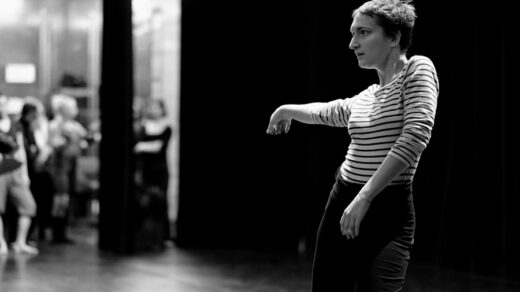Chilean writer Lina Meruane is driven by a question: “Is it true that faces portray and carry an identity?” Not really, she concludes. But what is a face, then? Or rather: What makes a face? Lena Baumann met Lina at the end of summer term.

“The face: an approach from many angles”, was the name of the seminar held by Samuel Fischer Visiting Professor Lina Meruane in the summer term of 2022. The writer was born in Santiago de Chile in 1970 and now teaches Latin American and Global literatures at New York University and conducts research in disease studies. The body as a venue for political conflict is a reoccurring topic in her literary work.
FURIOS: Lina, what sparked your interest in the human face?
Lina Meruane: I got interested in the face because I get misidentified all the time: I can be Turkish, Spanish, French, Italian, Peruvian, Israeli, or Palestinian. Because I am a very mixed person – my family can be traced back to different places and cultures – it is hard for others to locate me. All these situations made me wonder whether identity can be thought of as a fixed thing. Is my face my face? My face seems to be many faces and more so, my face is also what others think it is. So … is it true that faces portray and carry an identity as so many have claimed? I suspect not.
Your previous work has been centered on the body, why did you now shift to the face?
Well, the face is a part of the body.
Philosophers Gilles Deleuze and Félix Guattari, who you’ve read in class, suggest that the head belongs to the body, but not the face.
I tend not to cut off the face from the body – wouldn’t that repeat the philosophical tradition of cutting off the head from the body, the mind from the flesh? The body is a material part of an individual but also a key part of social encounters, face-to-face encounters; and it has meaning in politics. Deleuze and Guattari make this distinction because they are interested in thinking about the political production of faces. They don’t think about the carnal face, they think about how the face is produced for political purposes. How the dark face, the female face, is a cultural and political product, opposed to – and never as good as – the white male face (of which the western idea of the face of Jesus is the model). I don’t want to claim that bodies don’t carry faces, but the production of a face is a political process of giving the face a political meaning.
You are referring to the concept of facialization.
Yes. “The abstract machine of facialization” is really a political machine. All the philosophical texts we discussed in class referred to the cultural and political creation of a face. Even Judith Butler talks about how the media serve the narrative of power by producing or denying faces – which is, I think, a form of production by absence. The media can deny the appearance of certain faces or can exploit the face to give it a specific meaning. There are various ways in which faces can be made to mean things that they not necessarily are. Butler says this very interestingly: The face is not really a human face, it’s a catachresis (meaning: use of the wrong word for the context, editor’s note): The original meaning is displaced.
To categorize any kind of deviation?
Yes, the face is always also something else.
When I look at faces on social media, especially white female faces, they seem to all look the same. It seems as if these women on social media don’t really have their own face anymore.
The ideal face is a fantasy: a face of beauty, health, richness, celebrity, whiteness. But somehow, paradoxically, as you say, anyone who acquires that face turns invisible. A copy of a copy. Why would we want to be so homogeneous? There are certain faces that seem to promise us something: access to power, jobs, money, partners. Access to privilege. The price of that is having a standard, conventionalized face.
When did it become so important to “have” a face?
People always had faces, but not consciously. At the beginning of humanity, the centrality of a face had not yet been recognized, or at least, there had been no need to represent it. In the first cave paintings, full of sophisticated images of animals, there were no human faces at all. When people started to settle and found communities and develop the notion of belonging, property and power, they gave importance to lineages and to the founders of their community. Apparently, this is the time when it became important to have a face, to prove one’s belonging to a genealogy.
What is a face, then?
I really like Daniel Black’s definition; he writes that the face is a multi-layered, multiple phenomenon. It is the most visible part of the body, and it is a social device of encounter. It is also a product of the machine of faciality, and thus it can stop being ours to become something else, something that can allow us to be comfortable in society or that can exclude us. You can really observe this in Latin America. It is important to look at this from different angles and scientific disciplines to consider other layers and avoid oversimplification.
Most important to me, is today’s centrality of faces for our self-definition, and how fragile this process can be. How the face can facilitate privilege or deny it, depending on what it means to others, what it becomes politically and economically. When we think about the face from all these perspectives, we can no longer give one answer.
How does this work in Latin America?
As we are so mixed, ethnically and culturally, the face becomes “genetically opaque”, so to speak. We really cannot see where one person comes from. For me, as a Latin American, the importance of race and how it shows and is concealed, is fascinating. Even in open view, as the face is the most exposed part of our bodies. Interestingly, what seems to frighten us the most is a face that does not show itself (as if uncovered faces showed something). Covering our faces makes us suspicious. A woman with a burqa is a problem for some because they feel she does not show who she is, what she means …
Still, women who aren’t allowed to show their faces continue to be seen as a danger to the system because they have and will always have faces.
Good point. One must look at these realities from a situated position: too much has been said about these women and how their faces are covered, but very little about how they feel about this in their own terms. In Precarious Life, Butler touches upon that question. She claims that Afghani women’s faces were used as tokens of liberation, but also as a Western imposition of liberation. If you ask a religious Muslim woman, she might say she feels freer covering up, less demanded of, even protected. Butler does not suppose that all women who were liberated from the burqa want to be liberated from it, much less used as symbols.
In the seminar, you read El desierto y su semilla by Jorge Barón Biza. The novel is about an acid attack on the narrator’s mother’s face by his father. It seems as if the face as a marker of identity causes more violence than the body. Veiling the face can be a means of protection for women since they are often threatened especially because of the way they look.
I don’t know if they experience more violence, but surely a very specific form of violence. Exerting violence on a face is also producing a face, the face of a punished woman, the face of a woman stigmatized for being who she is. In this book, based on a true event, it is also interesting to examine how the narrator talks about what his father wanted.
What did he want?
He is said to have wanted to blind her with acid and to have him be the last person she saw. That is a very troublesome misogynistic idea: the domination of her body and even her memory. You will be my victim and I will be your master, stuck forever in your visual memory. That’s his desire, but what happens is that her eyes are saved, and the rest of the face is gone, which is not a better outcome, as this takes away her standing in society. Once she has been through several reconstructive surgeries, she tries to go back to her political career but is unable to do so due to her damaged face – and commits suicide. It destroys her identity, her public persona and, eventually, her life. The face here, again, becomes something else: The place where patriarchal violence is exerted, where patriarchal domination is forever visible.
Deleuze and Guattari describe facialization as the source of racism, classism and sexism. The acid attack is a specific kind of violence to the female face, but I am wondering if there are any specific kinds directed at the black, brown or indigenous face.
Specific forms of facial attack I am not sure of, and I wonder whether these are simply not needed as these faces are already marked as non-white. But I looked into the question of facial recognition technologies, which have increased so much. Did you know that Berlin and London are the most surveilled cities in Europe? Under the pretense of public security, our faces are constantly examined by active cameras that not only record but recognize and alert security systems.
But recognition is sometimes a fraud, especially when people are not white. These systems are much less precise with non-white people because the people behind the applications are white men. This makes facial recognition a manner of indiscriminate racial profiling. It’s quite terrifying. After the Holocaust, we had supposedly discarded the pseudo-science of physiognomy, so prevalent in the last two centuries: the idea that a face could be read, that a criminal personality under the face could be discovered and that bodies could be discarded, or worse, destroyed under these premises. But physiognomy has returned in the form of facial recognition, when people are targeted because of their faces, because they look like dangerous people. This is very unsettling. And no one is there to be made accountable, it is the camera that is doing the ugly work, under the old spell of objective science.



